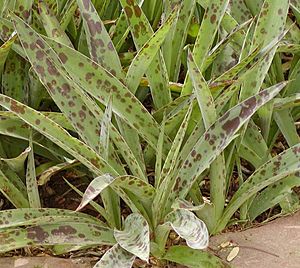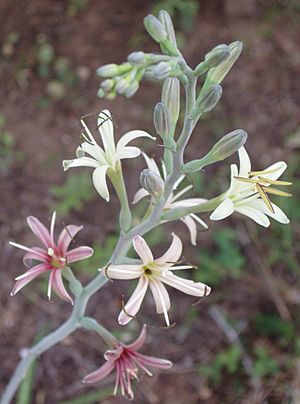Agave maculata facts for kids
Quick facts for kids Agave maculata |
|
|---|---|
 |
|
| Scientific classification | |
| Synonyms | |
|
Agave maculata, also known as the Texas tuberose or spice lily, is a special plant. It's a type of Agave plant that grows naturally only in southern Texas and northeastern Mexico. Sometimes, people call it by another scientific name, Manfreda maculosa, which is like a nickname or a past name for it.
Contents
What Does the Texas Tuberose Look Like?
The Texas tuberose has a very short stem, almost like it doesn't have one above ground. Its leaves are thick and a shiny silvery-green color. They are covered with cool purple spots!
Leaves and Flowers
- When there isn't much light, the leaves might lie flat on the ground.
- If there's a long dry period (a drought), the leaves can dry up and disappear. It might look like the plant is gone, but it's just waiting for rain.
- When it rains enough, a tall flower stalk grows. This stalk can be about 60 centimeters (2 feet) tall! It usually appears between April and September.
Animals and the Plant
- Small animals like javelinas, deer, and wild pigs sometimes eat the new flower stalks. This can stop the plant from flowering that year.
- These animals also eat the leaves, especially when food is scarce during dry times. This can make the plants weak or even kill them.
Flower Colors and Seeds
- The flowers of the Texas tuberose are very interesting. They change colors over three to four days!
- They start out white, then turn pink, and finally become a dark red.
- After the flowers bloom, the parts that hold the seeds (called ovaries) change too. They go from green to purple and then to black as they ripen into seedpods.
How Scientists Named This Plant
The scientific name Agave maculata has an interesting history.
First Discoveries
- A scientist named Eduard August von Regel first described this plant in 1856.
- Later, in 1859, another scientist named William Jackson Hooker described the same plant. He gave it the name Agave maculosa.
Changing Names
- For a while, the plant was known by Hooker's name, Agave maculosa.
- It was even moved to different plant groups, first to the genus Manfreda and then to Polianthes.
- But today, both Manfreda and Polianthes are part of the Agave group.
- Because Eduard von Regel described the plant first, his name, Agave maculata, is the official one. This is called "priority" in science.
Why This Plant is Important to Butterflies
The Texas tuberose plays a very important role in nature, especially for a special butterfly.
Home for Caterpillars
- This plant is the main "host plant" for the caterpillars of a rare butterfly called the manfreda giant-skipper.
- This butterfly is also known as the aloe skipper (its scientific name is Stallingsia maculosus).
- "Host plant" means it's the only plant the butterfly's caterpillars can eat to grow.
Protecting Butterflies
- If there are fewer Texas tuberose plants, it could be very bad for these butterflies.
- A drop in the number of Agave maculata plants could put the manfreda giant-skipper butterfly at risk of disappearing.
See Also

All content from Kiddle encyclopedia articles (including the article images and facts) can be freely used under Attribution-ShareAlike license, unless stated otherwise. Cite this article:
Agave maculata Facts for Kids. Kiddle Encyclopedia.


